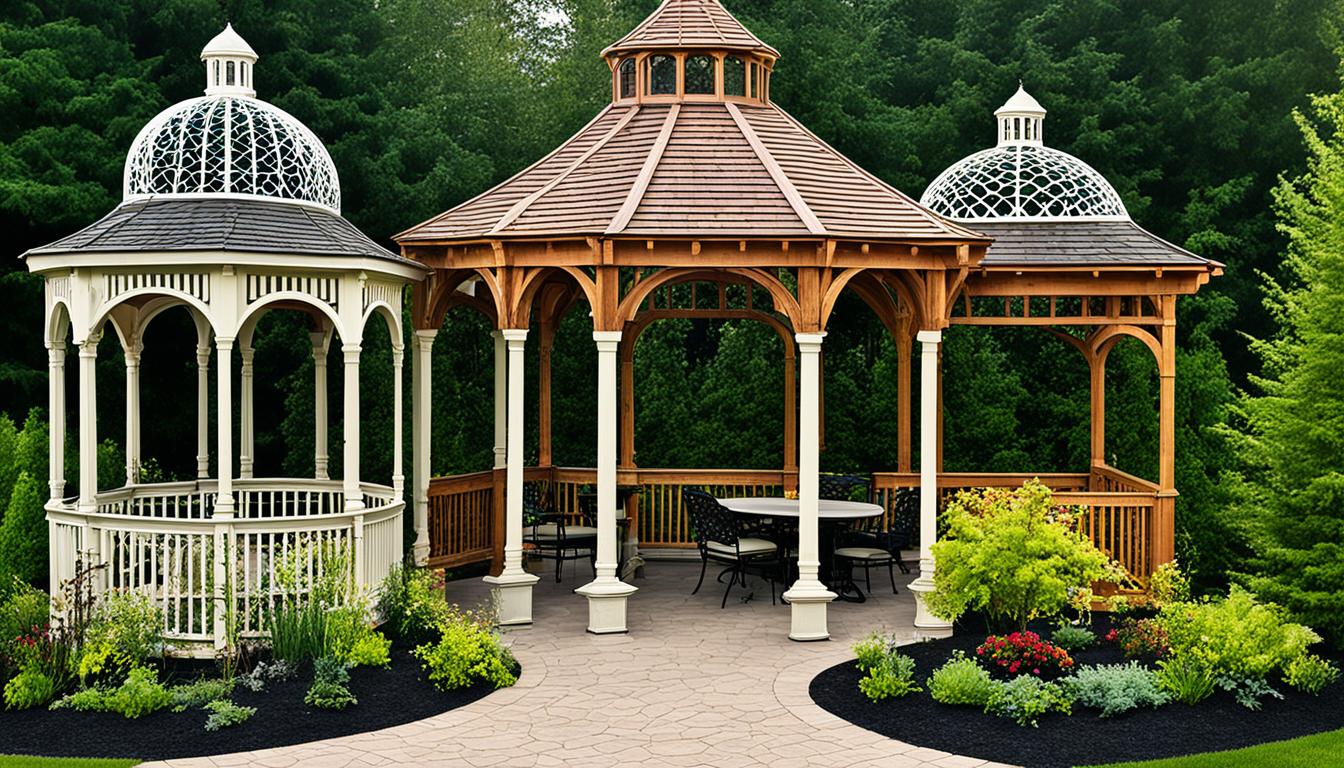The Ultimate Showdown: Gazebo vs. Pergola

Transform Your Outdoor Space: Gazebo vs. Pergola
Historical Charm Meets Modern Elegance
When it comes to choosing between a gazebo and a pergola, it’s essential to understand their unique histories and design evolutions. Gazebos, with their Victorian roots, exude historical charm and elegance. Their intricate latticework and finials add a touch of timeless beauty to any garden. In contrast, pergolas have become a modern staple in backyard design, offering a sleek and versatile option that blends seamlessly with contemporary home architecture. To understand the benefits of integrating plant life with pergolas,
Materials Matter: Gazebo vs. Pergola
Choosing the right material for your gazebo or pergola is crucial. Let’s break down the options:
- Wood: Offers a natural aesthetic and is easily customizable.
- Metal: Provides exceptional durability and a minimalist design.
- Stone: Adds superior longevity and can significantly enhance property value.
- PVC: Modern option that offers weather resistance and low maintenance.
Each material brings unique benefits to the table, ensuring that both gazebos and pergolas can meet diverse aesthetic and functional needs.
Design Versatility: Gazebo vs. Pergola
One of the key factors in the gazebo vs. pergola debate is design versatility. Gazebos are often standalone structures with solid roofs, making them perfect for complete shade and protection. They typically come with built-in seating, providing a cozy space for relaxation and socializing. On the other hand, pergolas can be freestanding or attached to your home. Their open, latticed roofs offer partial shade, creating an inviting space that integrates with the surrounding environment.
Enhancing Your Garden: Gazebo vs. Pergola
Both gazebos and pergolas enhance outdoor living spaces, but they do so in different ways. Gazebos serve as focal points in gardens and parks, offering a shaded retreat that invites people to sit and enjoy the surroundings. Their freestanding nature allows them to be strategically placed, maximizing their impact on the landscape.
Common Uses for Gazebos:
- Shaded seating areas in gardens and parks
- Outdoor dining spaces
- Wedding venues
- Event hosting
Common Uses for Pergolas:
- Patio and deck extensions
- Garden walkways
- Outdoor lounges
- Support for climbing plants
Integration with Nature: Gazebo vs. Pergola
Pergolas are particularly well-suited for integrating with nature. Their open structure supports climbing plants like roses, grapevines, and wisteria, enhancing the outdoor aesthetic and providing additional shade. This plant integration creates a lush, green retreat that’s perfect for morning coffee or evening relaxation. If you’re deciding between a gazebo and a pergola,
benefits of plant Integration in Pergolas:
- Enhanced privacy
- Natural shade
- Improved air quality
- Beautiful, fragrant blooms
Material Lifespan: Gazebo vs. Pergola
| Type of Gazebo | Material | Main Benefits | Average Lifespan |
|---|---|---|---|
| Wooden Gazebo | Timber, redwood, or cedar | Natural aesthetic, easily customizable | 10-20 years |
| Metal Gazebo | Wrought iron, aluminum, steel | Exceptional durability, minimalist design | 30-50 years |
| Stone Gazebo | Sandstone, granite, or marble | Superior longevity, adds property value | 50-100 years |
Choosing the Right Structure: Gazebo vs. Pergola
When deciding between a gazebo and a pergola, consider the following factors:
- Purpose: Do you need Full protection from the elements or a space that blends with nature?
- Style: Are you looking for historical charm or modern elegance?
- Materials: What materials best suit your climate and maintenance preferences?
- Space: How much space do you have, and how do you plan to use it?
To explore different material options for outdoor structures,
Pros of Gazebos:
- Full weather protection
- Built-in seating
- Timeless aesthetic
Pros of Pergolas:
- Versatile design options
- Supports plant life
- Integrates with home architecture
FAQs: Gazebo vs. Pergola
What is the main difference between a gazebo and a pergola?
- The primary difference in the gazebo vs. pergola comparison lies in their roofs. Gazebos have solid roofs for full protection, while pergolas have latticed roofs that offer partial shade and support plant growth.
Can gazebos and pergolas withstand harsh weather conditions?
- Gazebos generally hold up better in harsh weather due to their solid roofs. However, pergolas can also be built to withstand tough conditions, depending on the materials used.
Which is more versatile in terms of design, a gazebo or a pergola?
- Pergolas offer more design versatility as they can be freestanding or attached to your home. They also support plant integration, adding a unique aesthetic appeal.
Which structure is better for my garden, a gazebo or pergola?
- The choice between a gazebo and pergola depends on your specific needs. If you want full protection and built-in seating, a gazebo is ideal. If you prefer a structure that blends with your home and supports plants, a pergola is the better option.
Conclusion: Gazebo vs. Pergola
In the ultimate showdown of gazebo vs. pergola, the right choice depends on your personal preferences and outdoor space needs. Both structures offer unique benefits and can transform your garden into a stunning retreat. By considering factors like material, design, and intended use, you can make an informed decision that enhances your outdoor living experience. For more insights on gazebo and pergola designs, Check this out.